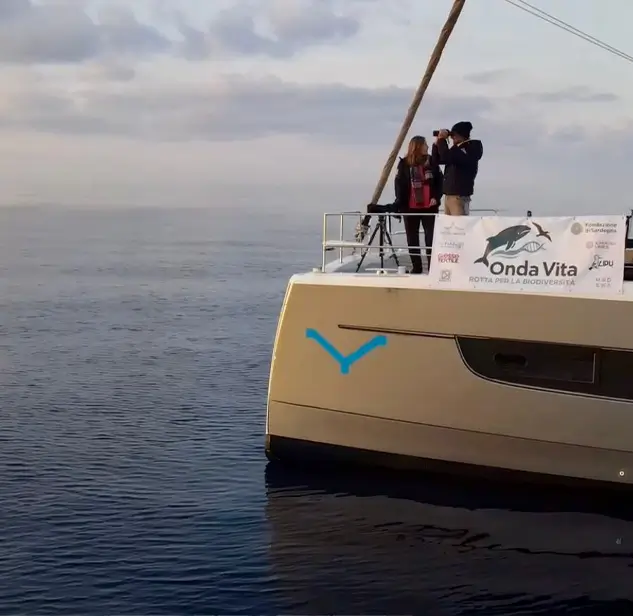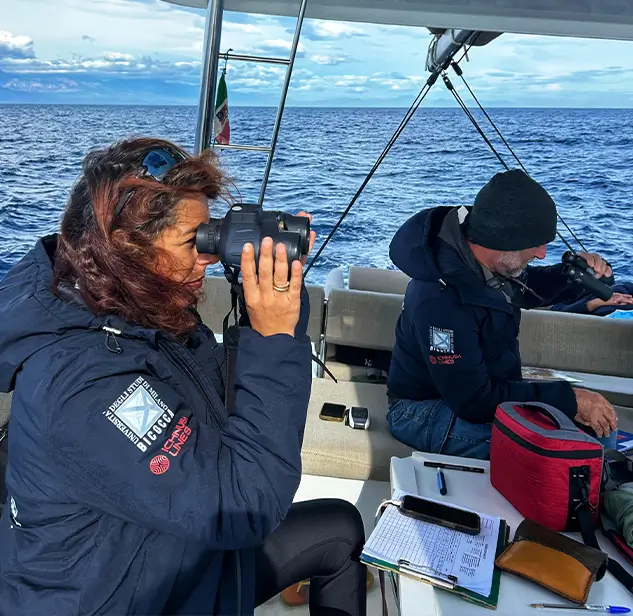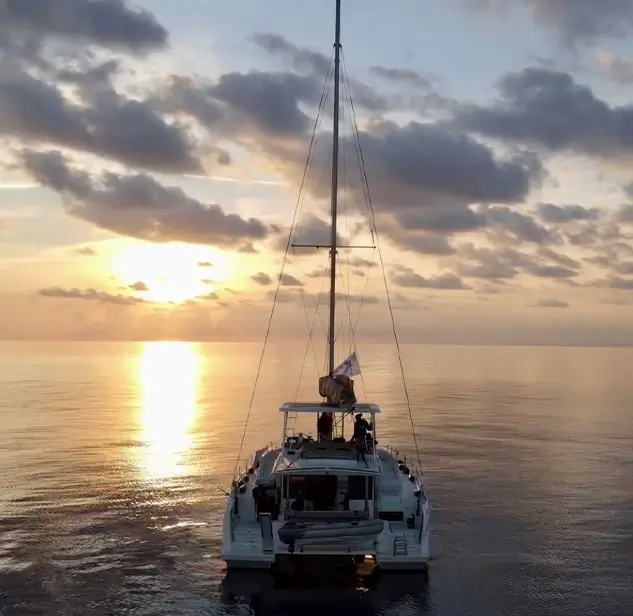OndaVita 2025: Ichnusa Lines supporting environmental sustainability
A journey through science, nature, and biodiversity
From October 18 to 25, 2025, the Tyrrhenian Sea hosted a unique event: the OndaVita expedition, a scientific and human adventure for which Ichnusa Lines was proudly the official partner.
On board the sailing catamaran ARGO, a crew of marine biologists, ornithologists, technicians, and researchers navigated for a week through the waters of the Tuscan Archipelago, Corsica, and northern Sardinia to collect essential data on Mediterranean marine and coastal biodiversity.
This was the first stage of the three-year project The Whales Journey, conceived by the La Beddula Cooperative, aimed at building a genuine network of knowledge and awareness around marine ecology and Mediterranean ecosystem protection.
The project was made possible thanks to the contribution of the Sardegna Foundation and partners (Amo Capo Testa-Punta Falcone, MEDSEA Foundation, LIPU, University of Milano-Bicocca) who helped make the OndaVita expedition for the safeguarding of the sea and biodiversity a reality.
Ichnusa Lines’ commitment goes beyond sponsorship: we support a shared vision that combines scientific research, environmental responsibility, and social engagement, contributing concretely to the United Nations 2030 Agenda Sustainable Development Goals (SDGs).

One project, six Sustainable Development Goals
Our support for the OndaVita expedition is part of a broader ESG (Environmental, Social, and Governance) path, where sustainability is an integral part of our business model. The project fully embraces six strategic SDGs, in line with Ichnusa Lines’ vision:
- Life below water: research activities directly contributed to ocean protection, conservation of marine ecosystems, and vulnerable species through biodiversity monitoring and mapping.
- Fighting climate change: we share OndaVita’s choice to apply low-impact scientific research techniques.
- Life on land: protecting the sea also means caring for the land. Analyzing the connections between marine species, birdlife, and coastal habitats will support an integrated approach to biodiversity conservation.
- Responsible consumption and production: the expedition adopted plastic-free practices and used biodegradable products to promote sustainable consumption models.
- Quality education: scientific dissemination is one of the key objectives of the project. We actively collaborate by supporting communication and spreading scientific culture.
- Partnerships for the goals: OndaVita arises from collaboration among research institutions, universities, NGOs, foundations, and responsible companies. We participate in this multidisciplinary model for a healthier and more protected Mediterranean.

The sea that speaks: silent voices of biodiversity
The OndaVita mission was a traveling scientific lab, a mobile base camp where crucial data on the health of our sea were collected daily.
During the week of navigation, the team on board carried out:
- cetacean monitoring, using advanced photo-identification techniques;
- ornithological surveys, to track the routes and habits of seabirds;
- environmental DNA (eDNA) sampling, one of the most innovative technologies in biology.
With an interdisciplinary, collaborative, and environmentally respectful approach, OndaVita combined science and passion, technology and respect. Every trace, sighting, and sample collected told us something valuable about our sea and its inhabitants.
eDNA: environmental DNA. What is it?
Every organism leaves a trace of its presence in the environment where it lives: skin fragments, cells, microscopic biological residues. Thanks to technologies developed by the University of Milano-Bicocca, scientists were able to collect water samples and analyze them to identify the presence of animal species, even without directly observing them.
An example?
The monk seal, a highly elusive species, could leave a genetic footprint in the sea, invisible to the human eye but detectable by scientific instruments.
It is as if the sea itself spoke, revealing who lives there, where, when, and under what conditions. It’s a non-invasive, ethical, and powerful approach and one of the cornerstones of this expedition.
Another major pillar of the mission was cetacean monitoring: common whales, stenella, bottlenose dolphins, and other large marine mammals navigating the Tyrrhenian Sea.
Through photo-identification techniques, researchers photographed dorsal fins and other distinctive body parts to recognize individuals. Each photograph became an identity card, a fragment of marine biography.
Simultaneously, the crew also conducted ornithological surveys, essential for understanding seabird presence and distribution, often true indicators of ecosystem health.
This work made it possible to assess the impact of human activities on marine fauna, monitor long-term behaviors, and design effective conservation strategies.

Sustainable route: Ichnusa Lines’ contribution
For Ichnusa Lines, the OndaVita expedition represented a key step in our commitment to the environment, a collaboration between the business and scientific worlds to promote sea protection and the spread of a culture of sustainability.
We have chosen to be partners of this expedition because we believe environmental education grows through knowledge, research, and concrete action. We want to be active participants in the transformation, not mere spectators.
The OndaVita project will culminate in a public conference at the Capo Testa Punta Falcone Marine Protected Area in Sardinia. It will be an opportunity open to all to present the expedition’s results in a clear and engaging manner. It will also be a moment of dialogue between science and society, aimed at reinforcing the sense of collective responsibility towards the sea and its resources.
A scientific documentary of the entire expedition through images and direct testimonies will be produced, showing research activities, techniques used, and species encountered. All informational materials will be accessible and usable by schools, educational centers, and local operators for educational activities and workshops. Objectives include:
- engaging the public, including non-specialists, on the importance of sea protection;
- highlighting the central role of Marine Protected Areas in biodiversity conservation;
- promoting the value of field scientific research as a solid basis for more effective environmental decisions.
We supported the OndaVita expedition to concretely contribute to building a more aware and active citizenship in safeguarding our marine heritage.
This journey through science, nature, and concrete commitment led us to discover biodiversity, making us realize that the Mediterranean still has much to tell us.
And we continue to listen to it.
